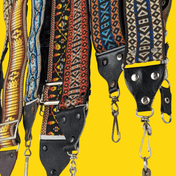One of the greatest advantages of using a Camera is its ability to accept a variety of interchangeable lenses. Each has its little charm and ability to make the impossible, possible. Mount a wide-angle lens to your camera and watch the world open around you, allowing a broader range of perspectives and photo opportunities. And when you pair your camera with a telephoto lens, the faraway comes in close, filling your frame with golden opportunities from faraway lands. Deciding what lens to use can be a cumbersome task on the best of days, but with different lenses to work with, you'll be amazed at how much more you can exploit from your camera, but first, we must take some time to learn the basics.

What is a prime lens?
A prime lens is a lens with a fixed focal length. This means that the field of view cannot be changed unless you are physically moving away or towards your subject. Prime lenses come in a variety of lengths, ranging from 24mm for a wider perspective, 50mm more commonly known as the ‘nifty fifty’ for a focal range that is like the human eye, 80mm lenses are more commonly used as portrait lenses or 800mm telephoto lenses for sports and wildlife.

What is a zoom lens?
A zoom lens is exactly as it sounds. By turning the zoom ring, you move the optical element of the lens to achieve a different field of view, this means that you can make your subject appear larger by turning the zoom ring, or you can make your field of view smaller by turning the zoom ring in the opposite direction. Zoom lenses have two points covering the minimum and maximum focal range within the lens, while also coving everything in between. For instance, with a 24mm F2.8 – 70mm lens, 24mm is its minimum focal length and 70 is it's maximum, it will also cover 35mm, 50mm, etc. Zooms lenses can also have variable aperture ranges, most often than not you'll see F3.5-5.6 which represents the minimum and maximum aperture and different focal points. For example, take a canon 18-55mm lens, which will have a maximum aperture of F3.5 at its widest point is 18mm, and a maximum aperture of F5.6 at 55mm.

Why choose a prime lens?
So why would you choose a prime lens? Well, here are just a few of the reasons why. One of the many advantages of prime lenses is the fixed focal point, during the golden age of photography (during the 60s/70s) many street photographers would only use a small arsenal of lenses, most commonly being a 24/35mm wide angle and a 50mm lens. Being a street photographer is all about being amongst the people, so what better way to do that than having to physically move toward your subject? This is always a great way to build confidence within yourself as a photographer, discover new compositions and break away from hiding behind your camera with a zoom lens. Prime lenses tend to be significantly cheaper than their zoom counterparts. Depending on various factors, a 24mm F2.8 lens can cost anywhere between £100 and £300, but a 24-70mm F2.8 can set you back thousands of pounds. Ahh, but you cover more focal range with a zoom lens I hear you say? Well, yes that is true. But you can cover the focal length between 24 and 70mm with an array of prime lenses for a much cheaper and they tend to be faster with the option of F1.8 lenses at your disposal. Lower aperture lenses tend to be slightly larger in size compared to other lenses, but with good reason. A lower aperture means your lens can take in more light, making it more versatile than its F2.8 counterpart.
Why choose a zoom lens?
Many users will buy zoom for the most obvious reason, that being its versatility. Zoom
lenses are great if you ever find yourself in a situation where you need to snapshot zoom. What is a snapshot? A snapshot is a fleeting moment that captures your eye, a moment that requires spur-of-the-moment camera work. It's moments like these where zoom lenses come into their own, a quick turn of the zoom ring and you can go from wide-angle to telephoto without the need to psychically move. Zoom lenses tend to have higher popularity among wildlife and sports photographers, which are often limited to a particular spot or area, so having the ability to zoom in on a subject or area of interest is paramount. A single zoom lens could replace an entire arsenal of lenses, eliminating the worry of deciding what lenses to use, this can also reduce the weight of your camera bag as you don’t need to bring several other lenses to cover an array of focal lengths. Eliminating the need to change lenses means you can solely focus on your subject matter and reduce the possibility of dirt and dust contacting your camera's mirror.

Summary.
Both zoom and prime lenses have their own advantages and come into their own during certain situations. Having to choose between the two is never easy, and it takes time to
realize what type of photographer you are and what lenses are for you. Some
photographers will choose a “do it all” zoom lens and they’ll take that lens to their grave; others will swear an almighty truce to the prime lenses gods and will look down on their
zoom friends with utter disgust. The fact of the matter is, we are all artists in our own right, all with a burning desire to create moments of eternal happiness and it doesn’t matter how we decide to create our craft.













